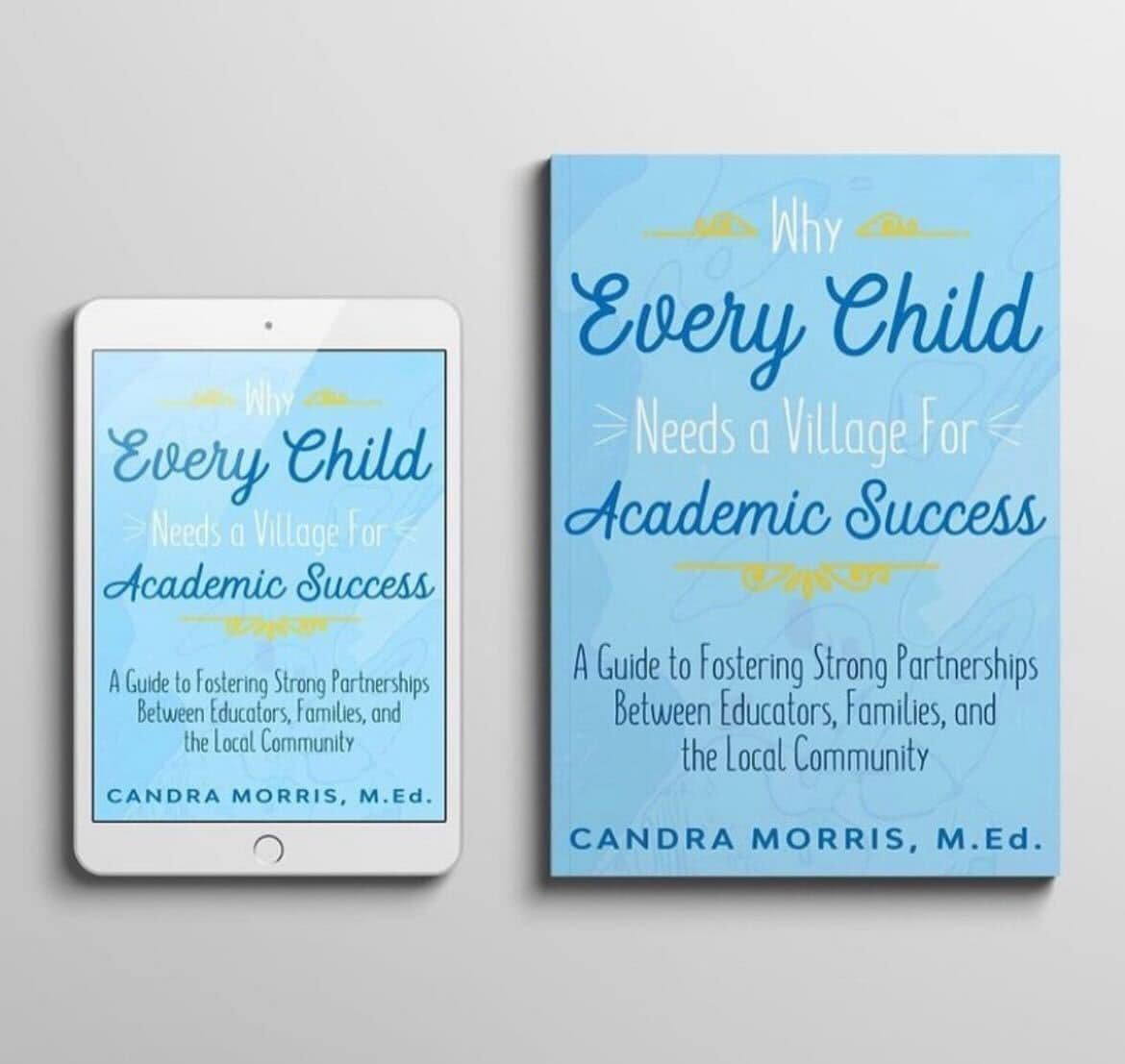Candra Morris is the Vice President of Professional Learning here at Waterford.org. She recently sat down with us to talk about family engagement, student success, and building relationships. We like to say she wrote the book on family engagement in schools—because she did!
What makes you so passionate about family engagement in education?

Candra: I think I’m just naturally passionate about it. I’m first-generation Liberian American, and family is an important part of our culture.
I went to school to become a teacher. You don’t really appreciate the importance of family engagement and working together academically until you’re in your own classroom!
I taught for schools with Title I funding in Prince George’s County in Maryland, and family engagement was a huge part of what we did in our daily work. Being able to work with the families in the communities, I saw the difference it made with my students.
Then when I came to Waterford and we had Waterford Family Nights, that just opened up my passion for working closely with families.
What benefits have you seen from family engagement?
Family engagement has huge benefits in early education! It helps student success overall when families understand what’s being taught in the classroom. You see a correlation, you see student academic achievement improving because they’re getting practice in more than one place.
Communication between families and educators in the school is so valuable, in part because if something happens at school, that relationship already exists. Then parents and educators are ready to collaborate and strategize to support individual student needs.
I’ve also seen family engagement help in terms of filling needs on both sides. Like, if there’s a special project or classroom assignment, having an established relationship with parents and caregivers means they’re able to help more as part of the school community. On the other side, if families need additional resources at home, they know they can reach out to the school and be connected with school or community resources.
It sounds like effective family engagement is all about relationships. How do you build those relationships?
Yes! I think back to my time as a classroom teacher. You build those relationships through establishing trust and listening to families. It starts through informal conversations. These are different from the more formal communication of, say, a parent-teacher conference. And there are opportunities all over! Like at drop-off, are you saying, “Hi, how are you doing?”
Are you taking those informal opportunities to greet them? Are you responsive to emails? Are you returning calls from parents and caregivers? Are you keeping them in the loop on what’s happening? Are you sending informal celebratory messages?
Keeping your word matters. If you’re not able to do something as an educator, or if things change, do you notify the child’s caregivers of that change? Communication really is the key to building and establishing those relationships based on trust.
Seeing families as a partner in education is, for me, the key to the relationship. It’s not that one is greater than the other. It’s about seeing each other as partners to help the student succeed. Truthfully, that starts by having a welcoming classroom and school community where families feel represented, not isolated.
How can educators help families feel represented and not isolated?
I always think about how families will come into your school from different cultural backgrounds and different walks of life. You just never know what the makeup of your classroom will be. It’s important to ensure inclusivity and make everyone feel welcome. You meet them where they are and try to establish a relationship with each individual family. It’s about considering all the families and finding ways to incorporate them into the classroom.
One idea is to create family collages that students can share. Then those are hung up so when families visit the classroom they feel, “Oh, we’re here, too!” Or you make sure to have different colored crayons so everybody is represented when you’re asking children to draw a picture of their family.
It may take time, but getting to know your students is a great way to learn about their families. You can take time during the day to pull on their background knowledge. When you’re reading a book about celebrations you can encourage students to talk about their own family’s celebrations. You can then find ways to bring their culture and home experiences into your classroom.
The child is our focus. The child spends time with both you and their family. That child is the one you all want to see succeed in every sense of the word! So when you keep the child in the forefront of your mind, you know you have to work together.
How can administrators plan for family engagement in their schools?
The administrator is the one who sets the tone for communication and collaboration with families. The administrator is also the one thinking about budgeting for family engagement or whether there’s a PTA. Part of their role is to make sure the educators have what they need to support the initiatives in their schools.
Ultimately, administrators are responsible for creating an inclusive environment, an intentional culture where every family that walks through the door feels welcomed and part of that school community. These are important ways to build trust. With that trust, working with families to strengthen academic success for students is possible.
To make that happen, administrators should get to know the students in the building and their families, so they have that rapport, too. I see the administrator as the person who can pull everyone together, educators and families alike, knowing what they all bring to the table.
I was so grateful to work with an amazing principal who modeled what it was like to be a servant leader. You have to understand that every role matters. Not just the teacher, but also the custodian, the front desk staff, the parents and caregivers, the safety patrols outside making sure children get across the street. All of those people play a role in student success.
The mutual respect among all these people is beneficial to children. Students know they have a village of support with a shared vision saying, “We want you to be your best.” They know they have all these people around them that are going to do whatever it takes to make sure that they are successful.
What are your favorite strategies for family engagement?
As a new teacher, I learned so much from veteran teachers about the importance of engaging with families. They really stressed that to me. I wrote the book Why Every Child Needs a Village for Academic Success as a practical guide for novice teachers to share all of those nuggets of wisdom that I learned being a classroom teacher. It focuses on fostering relationships with families and with community partners so that students are successful in and out of the classroom. Some of my favorite nuggets are:
- Get to know your families: It seems basic, but take time to say “Hello” at drop-off and make small talk. Those kinds of things go a long way.
- Be creative in your reach: Sending out a newsletter is a good way to let families know what’s happening in your classroom. But be intentional in the different ways you’re sharing that newsletter. Make sure you’re reaching every family—whether that’s a tool like ClassDojo, an email, a text, or a reminder that goes home in their daily folder. Look for a variety of ways to reach families.
- Don’t assume: Just because you don’t hear back from families, don’t assume you know why. You can stifle the relationships you’re trying to build by making assumptions about why families are not communicating. If you don’t know why, just ask.
- Get families talking to you: With traditional back-to-school nights and other events, we’re often just feeding people a lot of information. Think about ways to get information from your families. Ask what they want you to know about their child. Take time for them to tell you about their goals for their child and talk about how you can work together to make sure those happen. This can be in conversation, or more structured communication, like a family survey or a questionnaire. Give your families an opportunity to reflect and share at the end of the year—what it was like, what things worked well, etc.
What would a family engagement night look like in schools?
For us at Waterford, a family engagement night may look like a bingo night where they’re coming in and playing power-word [sight-word] bingo or phonics bingo. It might have a theme, like a “Books and Brownies” night our team did in South Carolina. We focus on a skill and an activity that families come together for.
A family engagement night in a school might be a game night, a literacy night, or a math night. It could even look like a movie night where folks come and watch a movie together as a family. Think of it as a fun activity or event that brings families together to have a good time while learning an academic skill.
How did you come to Waterford.org?
I was first introduced to Waterford by using the supplemental program in my classroom, and I saw it as a resource that really helped students—especially the multilingual learners in my class, whose primary language wasn’t English. Every teacher wants to be able to spend extra time with individual students, but it’s just not the reality sometimes. Waterford was like that extra teacher in my classroom. Eventually the organization was looking for someone to lead an expanded implementation in Prince George’s County with the Title I team, and I applied.
I think one of the sweet spots of working with Waterford is being able to be creative and innovative. You know that you’re working with a team of people that are intelligent and collaborative. You’re working toward the same mission.
Everyone is thinking, “How can we be supportive to families and students?” I love knowing that we can come up with new and strategic ways to support educators, families, and students.
That’s how Waterford Family Academy was born. When we go into schools with teachers and we work with families, we’re not there to tell them what to do. We’re there to partner and collaborate. The goal is to design plans and create strategies that will work for their school to encourage academic success. We’re there to learn together.
Thank you for your time and for sharing your expertise and passion with us, Candra.
If you would like to learn more about Waterford’s academic programs or Waterford Family Academy, visit Waterford.org.





